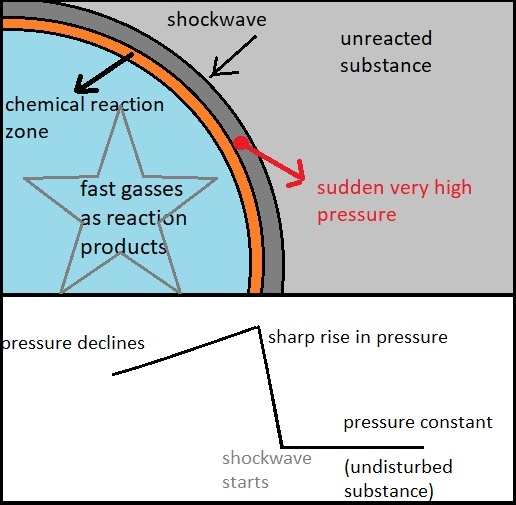| No: | Name: | Type (usually): | Chem. Formula: | D. velocity m/s: | Appearance: | Since: | Remark: |
| 1 | Mercury(II) fulminate | Primary High | Hg(CNO)2 or C2N2O2Hg | around 4200 | grey/white solid | Sensitive shock/friction. Used in detonators, caps etc.. |
|
| 2 | TATB (not TATP!) | Secondary High (needs detonator) |
C6H6N6O6 | around 7200 | Brown/yellow christals | Very insensitive. Used for very critical systems, where accidents must be ruled out. |
|
| 3 | TATP usually a mix |
Primary High | C6H12O4 / C9H18O6 / C12H24O8 | around 5000 depending on mix |
whitish solid | Very sensitive shock/friction | |
| 4 | RDX usually a mix expressed in different "compositions". Examples: Semtex, C-4. |
Secondary High (needs detonator) |
C3H6N6O6 | around 8000 depending on composition. |
whitish solid | Secondary High, thus needs a trigger. Very insensitive. |
|
| 5 | C-4 Based on 90% RDX. Additions made to make it moldable (clay like). |
Secondary High (needs detonator) |
like RDX | around 8000 depending on composition RDX. |
whitish clay like | Secondary High, thus needs a trigger. Very insensitive. |
|
| 6 | ANFO, ANNM Ammonium Nitrate+Fuel (Oil), Ammonium Nitrate+Nitro Methane + Fuel. Mixes of AmmoniumNitrate with a large choice of fuels. Very often Custom defined mixes. |
Secondary High (needs powerful detonator/primer) |
NH4NO3 (AN component) |
depends on mixture, around 3200 |
purple chrystalline substance | Very insensitive, needs powerful detonator/primer |
|
| 7 | PETN Can be used "alone", but often also as PETN and trinitrotoluene (TNT) to form "pentolite". Can also be used with RDX, as to form Semtex. Most mixtures are in plastic form. |
More of a Primary High due to it's relative sensitivity. Can be a Secondary High too. | C5H8N4O12 | around 8000 depending on mixture. | White crystalline solid | Medium sensitive for shock/friction. Can be viewed as a Primary High. A molecule has 4 Nitro NO2/3 groups. | |
| 8 | TNT (2,4,6-trinitrotolueen). Used by itself, or also often as a component with other explosive substances. Also, additives like Al are added, for Temp increase. Sometimes, Ammonium nitrate is added. |
Secondary High | C6H2CH3(NO2)3 | around 7000 | Yellow-brown chrystalline | Lower sensitive for shock/friction. Can be viewed as a Secondary High. A molecule has 3 Nitro NO2/3 groups. | 9 | HMX (octogen) One of the most powerful explosives. In some applications mixed with TNT. |
Secondary High | C4H8N8O8 | around 9000 | White solid, Colorless liquid |
Lower sensitive for shock/friction. Can be viewed as a Secondary High. A molecule has 4 Nitro NO2/3 groups. |
| 10 | NTO Nitrotriazolone |
Secondary High | C2H2N4O3 | around 7000, But several sources list different values. |
white crystalline solid | Low sensitivity. Often seen as follow-up of RDX. It's a better component for Insensitive Ammonition. |
|
| 11 | Composition B | Secondary High | About 60% RDX, 40% TNT, some wax See those for Chem. formula. |
around 8000 | Yellowish solid, usually pellets. | Relatively Low sensitivity, but not low enough for modern insights. Common in older Shells, Grenades, mortars etc.. Usually getting replaced by alternatives. | |
| 12 | Semtex See also RDX and PETN, as Semtex is a mixture of both. Several variants exists, determined by the % of RDX and PETN. Wax is added for molding (SBR). Also often called "pentrite". Instead of PETN, BCHMX might be used. Occasionally, instead of RDX, HMX might be used. |
Usually Secondary High, (or Primary High (see PETN)) |
Several % of (usually) RDX, PETN e.g. Semtex 1H: C6.39H11.36N5.34O7.91 |
around 7000, depending on composition. | different colours, moldable plastic-like substances | Usually low sensitivity. Sensitivity depends on composition. | |
| 13 | Lead azide (and other azides like sodium azide). |
Primary High Used in detonators, caps. Used in smaller quantities. |
Pb(N3)2) | around 5000 | white powder | Highly sensitive for shock/friction. | |
| 14 | Aziroazide azide as a nickname for 1-diazidocarbamoyl-5-azidotetrazole". Extremely sensitive. Almost never used. |
Primary High. | C2N14 Substance has many "weak" N bonds. |
around 8500 | -- | Extremely sensitive. Very sensitive for shock, friction, temp. Almost never used, unless for very special applications. |
|
| 15 | ETN | -- | -- | -- | -- | -- | -- |
